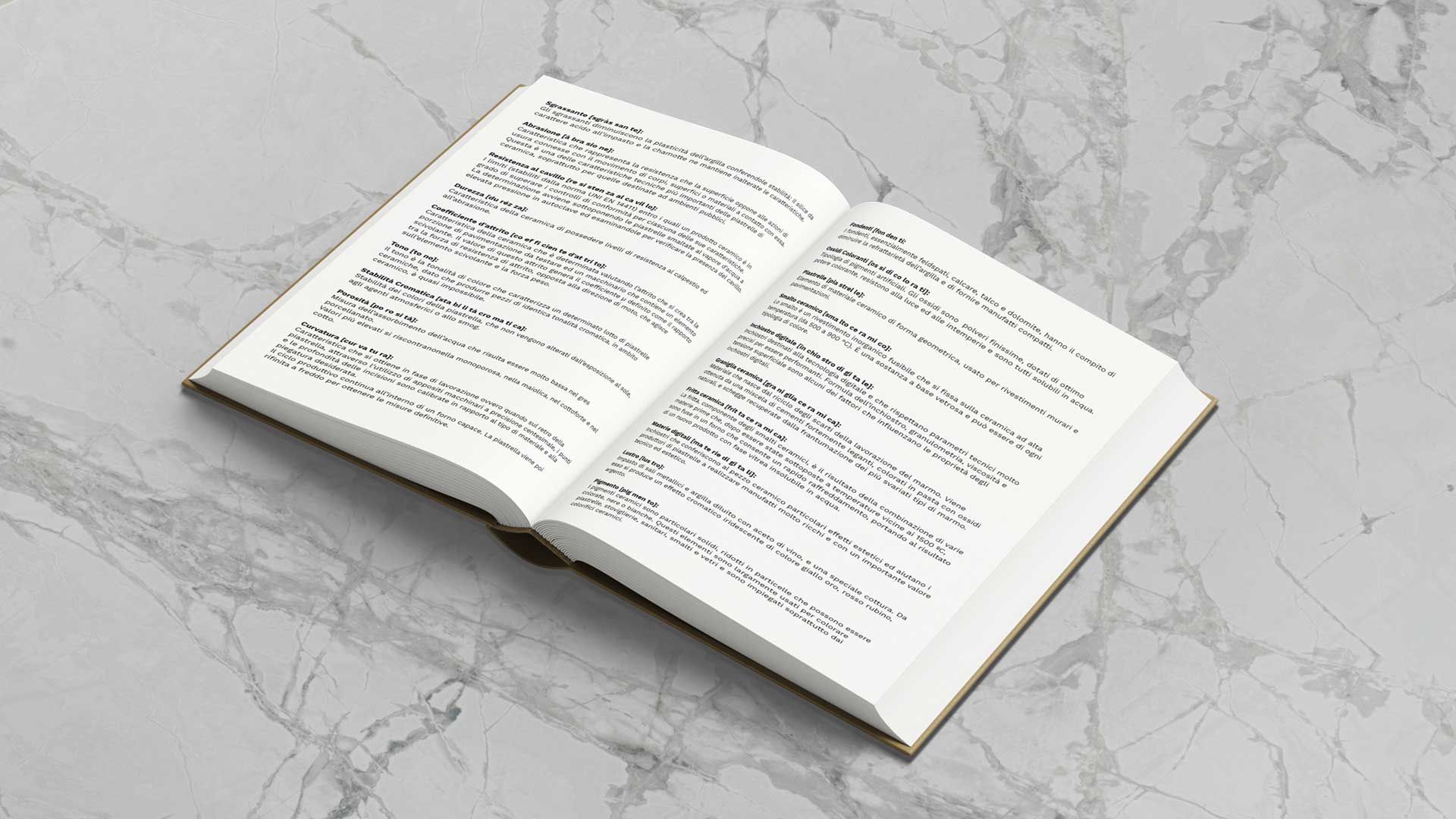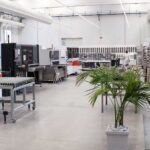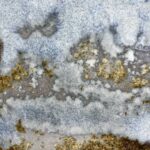Discover the wide world of the ceramic tile companies and suppliers of raw materials by scrolling through the categories of greatest interest.
Ceramic additives
Degreaser:
Degreasers decrease the plasticity of the clay giving it stability. The silica gives the mixture an acid character and the chamotte maintains its characteristics unchanged.
Characteristics of ceramics
Abrasion:
Characteristic that represents the resistance that the surface opposes to the wear actions associated with the movement of bodies, surfaces or materials in contact with it. This is one of the most important technical characteristics of ceramic tiles, especially for those aimed at public environments.
Crazing resistance:
The limits (established by the UNI EN 14411 standard) within which a ceramic product is able to pass the conformity checks for each of its characteristics.
The determination is made by subjecting the glazed tiles to high pressure water vapor in the autoclave and examining them to check for the presence of crazing.
Hardness:
Characteristic of the ceramic to have levels of resistance to trampling and abrasion.
Coefficient of friction / Non-slip:
Characteristic of the ceramic that is determined by evaluating the friction that is created between the portion of flooring to be tested and a machinery that contains a sliding element. The value of this friction generates the coefficient μ defined as the ratio between the frictional resistance force, opposite to the direction of motion, which acts on the sliding element and the weight force.
Tone:
The tone is the color tone that features a particular batch of ceramic tiles, since it is almost impossible to produce pieces of identical chromatic tone in the ceramic field.
Chromatic Stability:
Stability of the colors of the ceramic tile which are not affected by exposure to the sun, atmospheric agents or smog.
Porosity:
Measurement of water absorption which is very low in porcelain stoneware.
Higher values are found in monoporosa, majolica, cottoforte and terracotta.
Curvature:
Characteristic that is obtained during the processing phase that is when on the back of the ceramic tile, through the use of special centesimal precision machinery, the points and depths of the incisions are calibrated according to the type of material and the desired bend.
The production cycle continues inside a capable oven. The ceramic tile is then cold finished to get the final measurements.
Ceramic compounds
Slip:
A suspension of particles in water.
Klinker:
Ceramic tiles of small size and high thickness whose composite mixture is made up of low quality clays and kaolins, feldspathic fluxes and non-plastic materials. It is frost-proof, unalterable to chemical attack and with considerable mechanical resistance to bending.
Ceramic effects
Lapping:
Mechanical treatment aimed at removing the most superficial layers of a ceramic tile or slab. The effect of the treatment can lead to a “mirror” surface.
Materiality:
An effect that tends to make matter prevail, both in sight and in touch. It refers to a very fascinating grain and roughness effect.
Matt:
An effect that enhances the
opacity of the colors, which means that even the strongest colors are mitigated
while maintaining their liveliness.
A matt ceramic surface reflects a ray of light in a non-specular way; on the
contrary, the ray of light is diffused in all directions.
Glossy:
Effect that gives shine to the ceramic tiles, suitable for attracting light and attention. In a project, usually only a wall or a portion of a tiled wall is dedicated to glossy effect. Suitable especially for bathroom and kitchen.
Caranto:
Effect that derives from a type of sandy clay. The color varies from light brown to light gray, with ocher streaks.
Ceramic materials and substances
Bisque:
Ceramic support of first firing, free of coatings and vitrifiable decorations.
Crystalline:
Glassy, transparent or colored coatings. It aims to enhance the underlying decorative effect and to waterproof the ceramic surface.
The coloring is achieved through the use of natural lands: blue is obtained with cobalt, green with copper, purple and blue with manganese, brown and yellow with antimony and iron, while by adding tin oxide, the white is obtained.
Smaltobbio:
A very vitrified engobe.
Fluxes:
The fluxes, essentially feldspar, limestone, talc and dolomite, have the task of decreasing the refractory nature of the clay and providing compact products.
Coloring oxides:
Types of artificial pigments. The oxides are very fine powders, with excellent coloring power. They resist light and bad weather and they are all soluble in water.
Tile:
Element of ceramic material of geometric shape, used for covering floors and walls.
Ceramic glaze:
The glaze is a fusible inorganic coating that is fixed on the ceramic at high temperature (from 800 to 1250 ° C). It is a glass-based substance and it can be of any type of color.
Digital ink:
Inks intended for digital technology and which respect specific technical parameters to be performing. Ink formula, particle size, viscosity and surface tension are some of the factors that influence the properties of digital inks.
Ceramic grit:
Obtained from the crushing and sieving process of the frit in order to obtain the most suitable calibrated curve for the type of application.
Ceramic frit:
The frit, a component of ceramic glazes, is the result of the combination of various raw materials which, after being subjected to temperatures close to 1500 ºC, are melted in an oven that allows rapid cooling, leading to the result of a new product with glassy phase insoluble in water.
Digital materials:
Inks that give the ceramic piece particular aesthetic effects and help tile manufacturers to create very rich products with an important technical and aesthetic value.
Luster:
An iridescent chromatic effect of , for example, golden yellow, ruby red or silver color.
Pigment:
Ceramic pigments are particular bodies, reduced into particles that can be colored, black or white. These elements are widely used to color tiles, tableware, sanitary ware, glazes and glass and are mainly used by suppliers of raw materials of ceramic tile companies.
Digital glue:
Particular substance which, combined with special grits, allows to create different surfaces and effects, minimizing defects and porosity of the surface. Very long drying times allow the spreading of grit even at a later stage.
Clay:
One of the raw materials that make up ceramics. It originates from the decomposition of the granite rocks in hydrated aluminum silicates (kaolinite) which come with various impurities; it absorbs water and can be easily shaped.
Stoneware:
Used mainly to produce tiles for bathrooms and kitchens. It is obtained by natural clay combinations that produce ceramics called, in fact, greified. A temperature between 1200 ° C to 1350 ° C is required.
Ceramic mix:
Dough of clay and other substances with water. It is modeled and then consolidated by firing processes to manufacture majolica, porcelain, crockery, etc.
Porcelain:
Particular type of ceramic obtained from mixtures with kaolin (aluminum hydrosilicate kaolin – Al2O3 · 2 SiO2 · 2 H2O) and feldspar. It is obtained by cooking at temperatures between 1300 and 1400 ° C.
Terracotta:
Type of ceramic which, after the firing process, has a color that varies from yellow to red, thanks to the presence of salts or iron oxides. Terracotta is the most common building material, called with the name of brick.
Majolica:
Ceramic product composed of the biscuit coated with stanniferous glaze. The term probably comes from Majorca (Balearic island), from where this technique was imported.
Raw Materials
Kaolin:
Quality of clay with the chemical formula Al2Si2O5(OH)4, used for the manufacture of porcelain. It consists essentially of pure kaolinite, produced by the action of rainwater on feldspar.
Crete:
Clayey-limestone earth of light color up to being white, easily malleable and mainly used for pottery.
Ceramic techniques or processes
Moulding:
Technique that allows to “shape”. Among the various techniques used in modern industry, extrusion, lathe calibration, pressing, casting stand out.
Calibration:
Moulding technique consisting of shaping with a gauge the dough rotated by the lathe. Lathe calibration is used for those products that have revolutionary solids (plates, vases, cups).
Casting:
Casting or slipcasting is a technique used for the production of some ceramic products. A suspension of water and powdered clay, to which a small dose of electrolytes is added, is poured into a mold of porous material (plaster). The water is absorbed leaving only the solid shell (green) that takes its shape from the mold itself.
Firing:
Firing allows to change the dough into a cemented whole through chemical reactions that take place between the components of the mass.
Serigraphy:
Printing technique that is used to customize products or products of different materials to reproduce images, photos, logos and writings. In the case of classic screen printing, you work with a flat or rotary machine. In addition to the inks, other elements such as grits can be deposited on the product to obtain unique and special effects.
Drying:
Phase necessary before firing the moulded piece since rapid evaporation of the water contained in the product would cause the formation of cracks. At first the external part of the piece loses water creating a contraction of the pasta, then the internal part loses water with consequent movement of the same towards the outside, creating porosity.
Extrusion:
The extrusion allows to obtain low cost products of low value which geometrically respond to having an axis perpendicular to a fixed section.
The extruded tiles are obtained from the raw materials in paste and the shape is given by passing the paste through a special orifice.
Vitrification:
It is measured in relation to the water absorption capacity: less absorption means greater vitrification.
Double firing:
Type of firing of ceramic products obtained by firing the substrate and surface layer at different times. The first firing is used to consolidate the support, while the second firing stabilizes the surface glaze. Compared to the single firing, the double firing allows to obtain brighter products than the glazes, a better definition of the colors and a lighter weight.
Type of Ceramics
Raku ceramic:
Particular type of ceramic obtained with a technique that consists in the second firing, which takes place in a particular oven at temperatures ranging between 900 and 1,000 degrees Celsius in a highly reductive environment.







